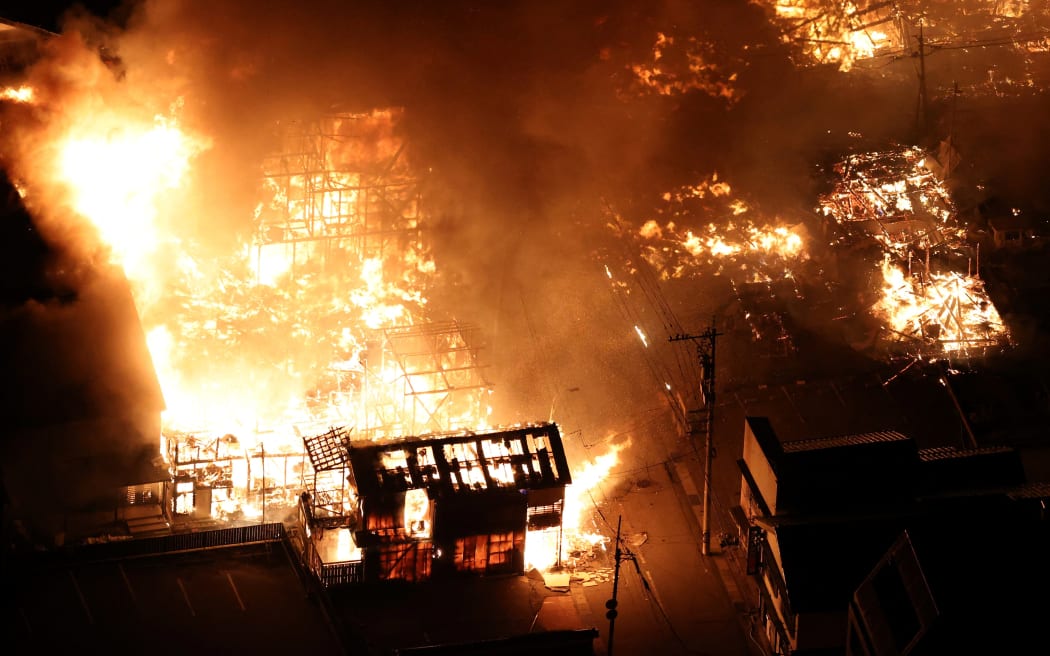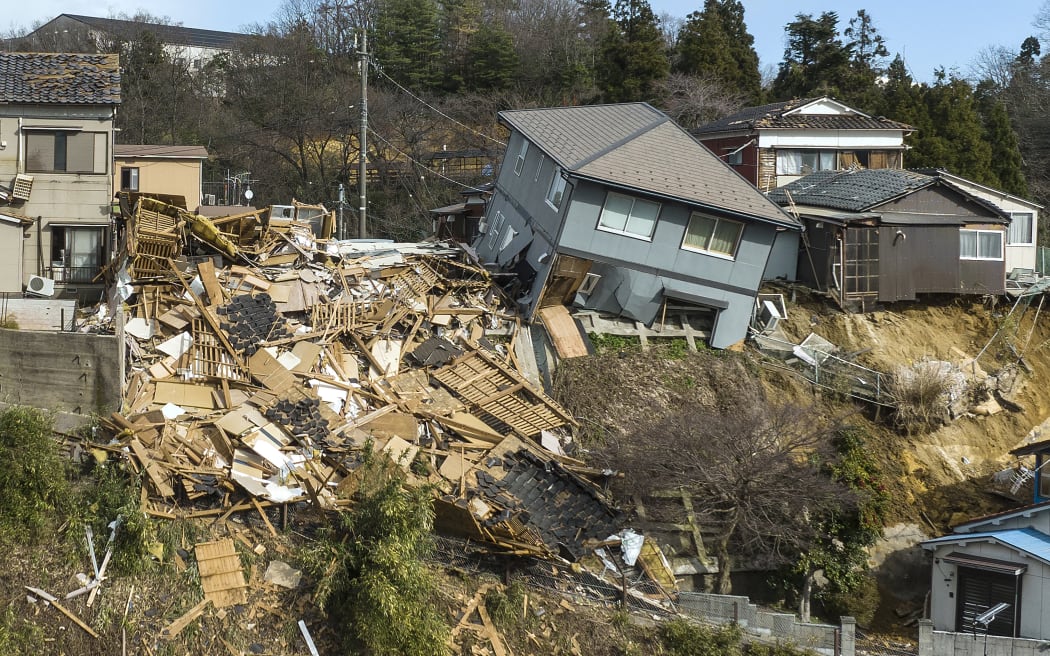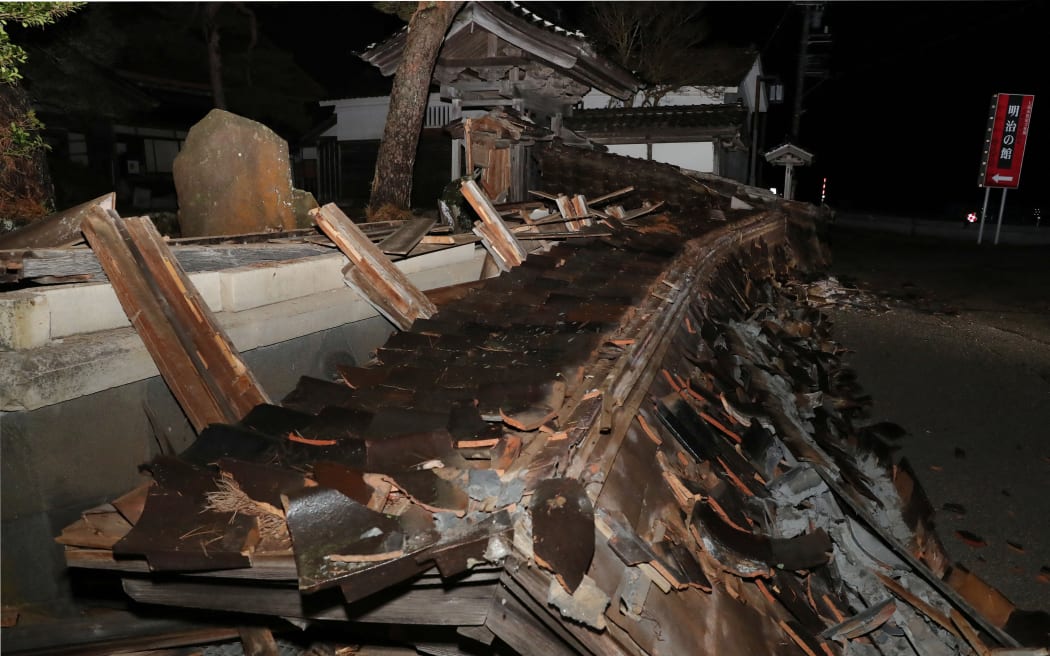UPDATED
Japan earthquake: Fires hit quake zone as rescuers race to reach survivors
Emergency services are in a "race against time" to rescue survivors.
Photo: STR / Yomiuri Shimbun / AFP
Rescue efforts continue in Japan after at least 62 people were killed in a powerful earthquake that hit the country on New Year's Day.
Homes collapsed, buildings caught fire and roads were extensively damaged, hindering the work of rescue services.
The epicentre of the 7.6 quake was the Noto peninsula, in central Japan.
The Japanese Prime Minister, Fumio Kishida, said emergency services were locked in a "race against time" to rescue survivors.
On Tuesday, Mr Kishida also said some 3000 rescuers were trying to reach parts of the Noto peninsula. Helicopter surveys showed many fires and widespread damage to buildings and infrastructure. The city of Wajima, on the northern tip of Noto, has been cut off from land routes.
In the coastal city of Suzu in Ishikawa prefecture, some 90 percent of homes in the city had been "completely or nearly completely destroyed", mayor Masushiro Izumiya told news outlet Kyodo.
The Japanese military has been handing out supplies including food, water and blankets for those who have had to vacate their homes. The country's government has said that 57,360 people had to be evacuated.
Tens of thousands of meals are being delivered across the affected region.
The epicentre of the 7.6 quake was the Noto peninsula, in central Japan.
Photo: AFP
Aftershocks continued throughout Monday and Tuesday. Japan's chief cabinet secretary Yoshimasa Hayashi warned people to "be alert" for more earthquakes "of an intensity of up to 7" in the coming week.
Ishikawa, 155km (96.3 miles) south of the Noto peninsula, experienced a 4.9 quake on Tuesday afternoon.
The major tsunami warnings put out by the Japanese government on Monday were later downgraded. By Tuesday, all tsunami advisories were lifted along the Sea of Japan, meaning there was no longer a risk of such an event.
Residents of the affected area of Japan have been sharing their experiences of the quake, which lasted several minutes.
An 82-year-old resident of Nanao, Toshio Iwahama, told the BBC that his wooden home had partially collapsed. He said that despite living through multiple earthquakes, he had never experienced tremors of this magnitude.
Many also said the quake reminded them of the devastating 2011 earthquake.
Photo: AFP / MASANORI INAGAKI
Briton Emma Ward, 41, who was on a skiing holiday in the resort village of Hakuba, said the quake had hit "without warning", prompting her group to take shelter under a table in a café. She told the BBC that the intensity of the tremors caused people to flee the building entirely, she said. "The worst part during the earthquake was not knowing how intense it was going to become. It's a very frightening experience," Ward said.
Many also said the quake reminded them of the devastating 2011 earthquake and tsunami that killed 18,000 people and triggered an accident at a nuclear plant in Fukushima.
In an incident unrelated to the earthquake, a Japan Airlines plane caught fire on Tuesday as it collided with a coastguard aircraft on its way to provide earthquake relief at Tokyo's Haneda airport.
Five people on board the coastguard plane are known to have died, but the Japan Airlines plane's 379 passengers and crew managed to escape.
Japan is one of the most seismically active nations on Earth, owing to its location on the so-called Pacific Ring of Fire.
Japan quake toll rises to 57, more tremors likely
Hiro Komae and Yuri Kageyama
Jan 03, 2024
A series of powerful earthquakes that hit western Japan left at least 57 people dead and damaged thousands of buildings, vehicles and boats as officials warned more quakes could lie ahead.
Aftershocks continued to shake Ishikawa prefecture and nearby areas a day after a magnitude 7.6 temblor slammed the area on New Year’s Day.
The damage was so great that it could not immediately be assessed. Japanese media reports said tens of thousands of homes were destroyed.
Water, power and cell phone services were still down in some areas.
Two of the latest reported deaths came from Suzu, where the death toll grew to 22, according to city officials. In nearby Wajima city 24 people died.
Although casualty numbers continued to climb gradually, the prompt public warnings, relayed on broadcasts and phones, and the quick response from the general public and officials appeared to have limited some of the damage.
Toshitaka Katada, a University of Tokyo professor specialising in disasters, said people were prepared because the area had been hit by quakes in recent years. They had evacuation plans and stocks of emergency supplies.
“There are probably no people on earth who are as disaster-ready as the Japanese,” he told The Associated Press.
Japan is frequently hit by earthquakes because of its location along the Ring of Fire, an arc of volcanoes and fault lines in the Pacific Basin.
Katada warned the situation remained precarious and unpredictable. A March 2011 quake and tsunami in northeastern Japan had been preceded by other quakes.
“This is far from over,” Katada said.
Japanese media’s aerial footage showed widespread damage in the hardest-hit spots, with landslides burying roads, boats tossed in the waters and a fire that had turned an entire section of Wajima city to ashes.
Japan’s military dispatched 1000 soldiers to the disaster zones to join rescue efforts, Prime Minister Fumio Kishida said Tuesday.
“Saving lives is our priority and we are fighting a battle against time,” he said. “It is critical that people trapped in homes get rescued immediately.”
A quake with a preliminary magnitude of 5.6 shook the Ishikawa area as he was speaking. Quakes continued to rock the area, reaching more than 100 aftershocks over the past day.
Nuclear regulators said several nuclear plants in the region were operating normally.
On Monday, the Japan Meteorological Agency issued a major tsunami warning for Ishikawa and lower-level tsunami warnings or advisories for the rest of the western coast of Japan’s main island of Honshu, as well as for the northern island of Hokkaido.
The warning was downgraded several hours later, and all tsunami warnings were lifted as of early Tuesday. Waves measuring more than one metre hit some places.
Still, half-sunken ships floated in bays where tsunami waves had rolled in, leaving a muddied coastline.
People who were evacuated from their houses huddled in auditoriums, schools and community centres. Bullet trains in the region were halted, but services was mostly restored by Tuesday afternoon. Sections of highways were closed.
Weather forecasters predicted rain, setting off worries about crumbling buildings and infrastructure.
The region includes tourist spots famous for lacquerware and other traditional crafts, along with designated cultural heritage sites.
US President Joe Biden said in a statement that his administration was “ready to provide any necessary assistance for the Japanese people.”
-AAP
The phenomenon of land sifting following the series of 155 earthquakes has been put forward by Japan's Geospatial Information Authority, known as GSI, after meticulous analysis of GPS data following the 7.6 magnitude quake

Visual from Japan's earthquake-hit Ishikawa Prefecture AP
Outlook Web Desk
UPDATED: 02 JAN 2024
As a crucial geological development amidst the catastrophic series of earthquakes in the island country of Japan, the land in the Noto region near the epicenter has shifted to the west by 1.3 meters. 155 powerful earthquakes rocked the Ishikawa Prefecture on Monday.
About the land shifting
The phenomenon of land sifting has been put forward by Japan's Geospatial Information Authority, known as GSI, after meticulous analysis of GPS data following the 7.6 magnitude quake. According to the geological watchdog, preliminary figures indicated that an observation point in Wajima City in Ishikawa Prefecture experienced the biggest shift, moving horizontally about 1.3 meters to the west.
Moreover, the data analysis also points to a westward shift of about 1 meter in Anamizu Town and 80 centimeters in Suzu City while an observation point in Nanao City's Notojima has been displaced by 60 centimeters northwest toward the Sea of Japan coast.
Land appears to have shifted about 20 centimeters to the northwest in the prefectures and Niigata. Several centimeters of land shifts were also observed in the Kanto-Koshin elsewhere.
Japan Earthquake: Death Toll Reaches 64, Major Aftershock Possible Over Next 7 Days
Japan Earthquake LIVE Updates: At least 62 people have died in quake-hit Japan, with the toll expected to go higher as many are said to be still stuck under collapsed houses

UPDATED: 03 JAN 2024
The death toll in Japan earthquakes has reached 64, with aftershocks still shaking parts of the country amid a warning that more quakes could lie ahead. The country has been hit by more than 155 earthquakes since Monday.
The Japan Meteorological Agency reported earthquakes hitting western Japan's Ishikawa and nearby prefectures shortly after 4 pm (local time) on Monday, with one of them measuring a preliminary magnitude of 7.4-7.6. A tsunami alert was issued for Ishikawa and nearby prefectures of the Japan sea side and huge waves began hitting the coast shortly.
Scary visuals of damaged houses, cracked open roads, and shaking buildings have emerged since then, suggesting that the death toll is expected to go higher. Japanese media reports said tens of thousands of homes were destroyed.
Water, power and cell phone service are also reportedly still down in some areas.
Japan Earthquake-Tsunami Latest Updates:
-64 Killed in Japan: Rescue operations are underway in earthquake-hit Japan, where officials say 64 people are confirmed dead and many still feared trapped under collapsed houses. Japan's Ishikawa prefecture, where majority of the earthquakes, including the one that measured 7.6, is the worst hit.
In Ishikawa prefecture's Wajima city, 25 houses are said to have collapsed while quake-triggered fires have also destroyed about 200 houses, Japanese public broadcaster NHK reported. In nearby Suzu City, officials confirmed more than 50 houses have been levelled.
ALSO READ | 155 Earthquakes Trigger Massive Tsunami Waves in Ishikawa
Japanese media's aerial footage showed widespread damage in the hardest-hit spots, with landslides burying roads, boats tossed in the waters and a fire that had turned an entire section of Wajima city to ashes.
-Thousands Without Electricity: Tens of thousands remain without electricity in Japan, while scores in affected prefectures are also sheltering at evacuation centres. Water supplies in some areas have been cut off, leaving residents to line up to receive drinking water, NHK reported.The quake also triggered mudslides that shut several roads

Major Aftershock Warning Issued: While casualty numbers continue to climb gradually, officials have warned people over for possible earthquakes with an intensity of seven on the Japanese scale over the next week. The Japanese scale runs from zero to seven, with seven being the strongest. The prompt public warnings relayed on broadcasts and phones, and the quick response from the general public and officials appeared to have limited some of the damage.
The highest-level tsunami alert, which was issued in Japan on Monday, has been lowered but residents of coastal areas have been asked not to return to their homes as deadly waves could still come.
ALSO READ: 'A Race Against Time To Save People': Scenes Of Devastation Strike Japan On New Year
-1,000 Soldiers Deployed: Japan's military has deployed 1,000 soldiers to the disaster zones to join rescue efforts, Prime Minister Fumio Kishida said on Tuesday. "Saving lives is our priority and we are fighting a battle against time... It is critical that people trapped in homes get rescued immediately," news agency AP quoted Kishida as saying.
A quake with a preliminary magnitude of 5.6 shook the Ishikawa area as PM Kishida was speaking.
Nuclear Plants Operating Normally: Nuclear regulators have said several nuclear plants in Ishikawa region were operating normally. The massive earthquake and tsunami of 2011 had caused three reactors to melt and release large amounts of radiation at a nuclear plant in northeastern Japan.



No comments:
Post a Comment